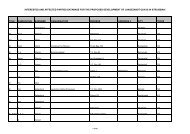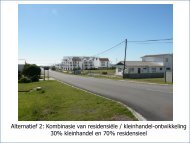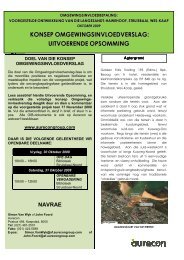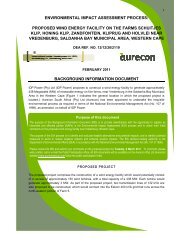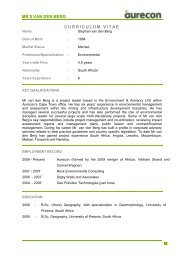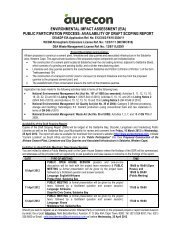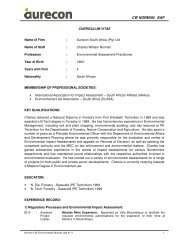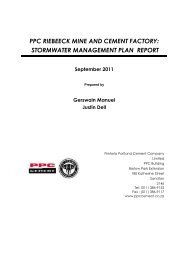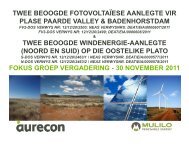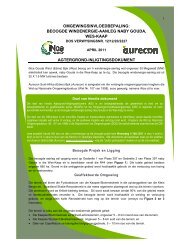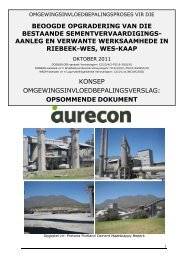Final EIAR - Aurecon AME Environmental | Environmental Projects
Final EIAR - Aurecon AME Environmental | Environmental Projects
Final EIAR - Aurecon AME Environmental | Environmental Projects
You also want an ePaper? Increase the reach of your titles
YUMPU automatically turns print PDFs into web optimized ePapers that Google loves.
Proposed Wind and Solar (Photovoltaic) Energy Facilities on Kangnas Farm near Springbok in the Northern Cape: <strong>Final</strong> EIR 32<br />
3.2 DESCRIPTION OF THE PROPOSED ACTIVITIES<br />
3.2.1 Wind Energy Facility project<br />
The proposed wind energy facility would consist out of four phases of 140 MW each, the<br />
turbine sizes would range between 1.5 – 4 MW which means each 140 MW phase may consist<br />
of between 94 (using 1.5 MW machines) to 35 turbines using 4 MW machines). The combined<br />
four phases would have a maximum total installed capacity of 560 MW. The size of the turbines<br />
would be selected by the developer in a tender process nearing the point when this project is<br />
nearing the DoE’s procurement programme, the final turbine would be selected based on fit for<br />
site technology, cost of technology available within required timelines, local content achieved by<br />
respective turbine suppliers, turbine dimensions and numbers approved within this<br />
environmental study, etc.<br />
A wind turbine is a rotary device that extracts energy from the wind. If the mechanical energy is<br />
used directly by machinery, such as for pumping water, cutting lumber or grinding stones, the<br />
machine is called a windmill. If the mechanical energy is instead converted to electricity, the<br />
machine is called a wind turbine. Figure 3.1 shows a wind energy facility in Texas, United<br />
States of America.<br />
3.2.2 Components of a wind turbine<br />
Wind turbines can rotate about either a horizontal or a vertical axis. Turbines used in wind farms<br />
(see Figure 3.1) for commercial production of electricity are usually horizontal axis, threebladed<br />
and pointed into the wind by computer-controlled motors, as is proposed for this project.<br />
These have high tip speeds of over 320 km/hour, high efficiency, and low torque ripple, which<br />
contribute to good reliability.<br />
The main components a wind turbine is made up are listed and described below (see Figure<br />
3.2):<br />
• Rotor and blades;<br />
• Nacelle;<br />
• Generator;<br />
• Tower; and<br />
• Foundation.<br />
3.2.2.1 Rotor and blades<br />
The rotor has three blades that rotate at a constant speed, approximately 6-15 revolutions per<br />
minute (rpm) in the case of the turbines being considered at Springbok. The blades are usually<br />
coloured light grey and, in the case of the proposed project, would be approximately 40 – 60 m<br />
long (80 – 120 m rotor diameter).<br />
© <strong>Aurecon</strong> (2012) No unauthorised reproduction, copy<br />
or adaptation, in whole or in part, may be made.<br />
P:\<strong>Projects</strong>\108495 Kangnas WEF & PV EIA's\3 Project Delivery\4 Reports\FEIR\FEIR 210213 <strong>Final</strong>.doc


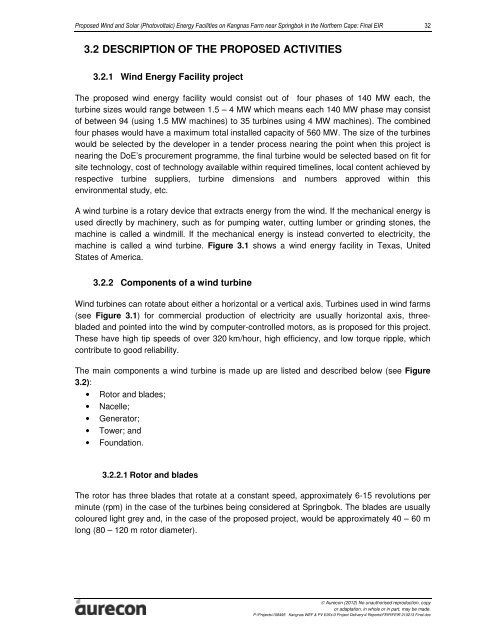
![CRR IV FEIR ~ 26042010 [FINAL].pdf - Environmental Projects](https://img.yumpu.com/21973020/1/184x260/crr-iv-feir-26042010-finalpdf-environmental-projects.jpg?quality=85)
